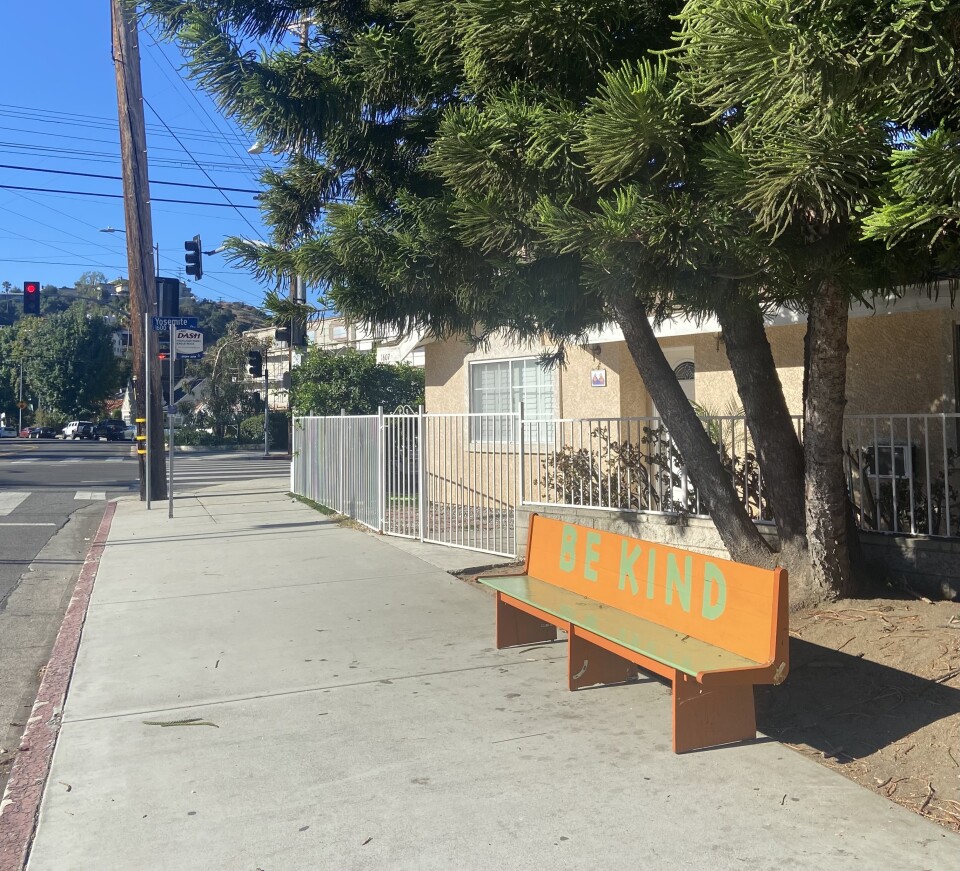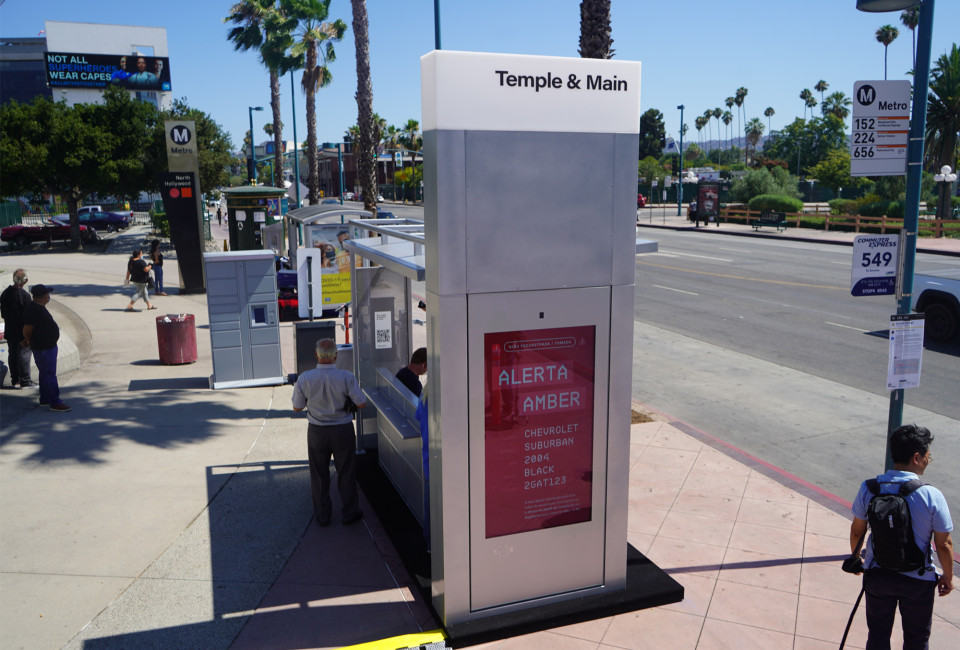Truth matters. Community matters. Your support makes both possible. LAist is one of the few places where news remains independent and free from political and corporate influence. Stand up for truth and for LAist. Make your year-end tax-deductible gift now.
LA Aims To Add Thousands Of Bus Shelters Across The City, But The Plan Has ‘A Lot Of Ifs’

In a 12-1 vote, the Los Angeles City Council on Tuesday approved a new contract to provide more bus shelters across the city.
The goal is to address decades of neglect in communities where people rely on buses, but often have no shade or places to sit while experiencing dangerous heat.
Through the contract, the city will pay Tranzito-Vector, LLC to “install, upgrade, and maintain transit shelters,” plus develop separate shade structures and other amenities — and manage advertising on digital screens to be featured on some shelters.
The bus shelters are expected to include monitors so riders can view real-time bus arrival times. The contract also includes plans for scooter docks, e-lockers, public Wi-Fi and phone charging stations.
The work will be managed by the city’s Bureau of Street Services through its new Sidewalk and Transit Amenities Program, dubbed STAP for short. The 20-year contract — an initial term of 10 years with two five-year extension options — is set to begin at the start of 2023.
The city’s goal is to add 3,000 new bus shelters with equity in mind. L.A. has several thousand bus stops, but the vast majority of them do not have shade. As extreme heat gets more frequent, many Angelenos waiting for their buses are competing for slivers of shade near stops — or else withering in the sun.
Given that the majority of public transit riders in L.A. County are Latino or Black and qualify as low-income residents, that means communities that rely on transit the most have the least relief from heat as they wait for the bus.

As Jessica Meaney, executive director of mobility advocacy organization Investing in Place, put it, channeling Tom Petty: “The waiting is the hardest part” for bus riders.
Meaney’s team published a report this week, titled The Bus Stops Here. It documents hundreds of observations and bus riders’ personal experiences on six crucial bus lines across the city. Refuge from the sun was a common concern for riders, Meaney noted.
“People want just shade, a tree, a pleasant place to sit,” she told LAist. “It's not really anything too complicated.”
Ahead of Tuesday’s vote, Councilmember Mike Bonin, who represents Westside communities in L.A.’s 11th District, shared his recent experience waiting for a bus near City Hall.
“It was brutal. It was hitting close to 100 that day. People were suffering standing there in the heat. The people who were there were up against a building which had a narrow sliver of shade as if they were on the edge of a ledge. It was so hot and so uncomfortable that there was a guy there who gave a bottle of water to a stranger because he was afraid that this woman — this senior citizen — was going to pass out. And that is the reality of bus shelters in Los Angeles.”
Lingering Concerns
While the goal is clear, how the city will fund and implement the shelter plan is not. So far about $6 million has been identified as available funding — $1 million from the city’s budget and $5 million from the L.A. County Metropolitan Transportation Authority.
City leaders approved the contract, but some voiced concerns about the city’s ability to follow through on investment long-term (something officials have already acknowledged is not their forte).
The lone “no” vote came from Councilmember Monica Rodriguez, who said the contract is “already showing signs of some unfulfilled promises.”
“We know we’re able to do this… I'm just concerned at what cost, without fully committing ourselves in terms of what the actual financial obligation is going to be and the determination of what it's going to mean for future budgets to fully implement this and actually make sure that we're not selling people a mirage and a promise that will end up being unfulfilled.”
The city has been down this road before. This new contract will follow a 20-year contract the city signed with Outfront/JCDecaux. But as KPCC has previously reported, that program mostly failed to deliver. According to recent reporting by KCET, the contractor reported installing just 660 bus shelters in 20 years.
Bonin also raised concerns about the contract, saying it contains “a lot of ifs” and “some question marks that I worry about.”
“But the reality of what is happening now is absolutely unacceptable,” he said.

Some residents opposed to the plan say the digital ads will be an eyesore and potentially distract passing drivers. City officials noted that the screens are much smaller than the typical billboards that dot city streets. Under the contract, less than 700 of the proposed 3,000 new bus shelters would include digital panels displaying ads.
The program will also mean money for L.A. The contract grants the city a 60.5% share of ad revenue generated from digital bus shelters.
That’s an uncomfortable reality for Meaney.
“The fact that we won't invest in improving our bus stops unless it's tied to advertising is such an outdated and, frankly, punishing position to take for people who ride the bus who are already dealing with a bus service that hasn't really seen significant improvement in 30 years,” she said.
Bonin also noted he’s not a fan of a "bus shelter program based around advertising.”
“Other cities just do it — they fund it,” he said during Tuesday’s meeting. For him, approving the contract came down to a simple fact: many bus riders don’t have other transportation options.
“Because we don't have enough amenities, they suffer …and they suffer more because of the worsening climate crisis,” Bonin said. “So in a balance between my distaste for digital advertising and my desire to make sure that we provide for bus riders, that's an easy choice to make today.”







